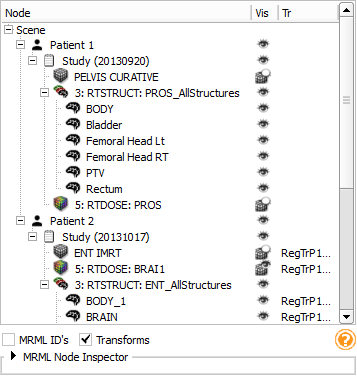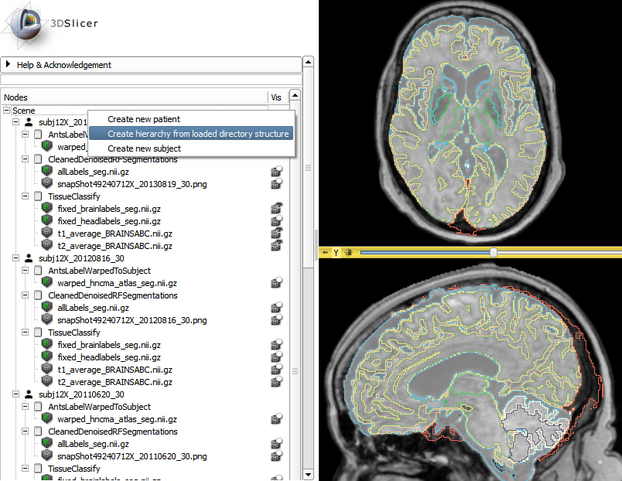Difference between revisions of "Documentation/4.5/Modules/SubjectHierarchy"
(Removed deprecated Contours information) |
(Added note about CreateSubjectHierarchyNode) |
||
| Line 30: | Line 30: | ||
{{documentation/{{documentation/version}}/module-section|Use Cases}} | {{documentation/{{documentation/version}}/module-section|Use Cases}} | ||
| − | {| | + | {| |
| | | | ||
* Load DICOM data and need to see in the same hierarchy | * Load DICOM data and need to see in the same hierarchy | ||
| Line 42: | Line 42: | ||
<!-- ---------------------------- --> | <!-- ---------------------------- --> | ||
{{documentation/{{documentation/version}}/module-section|Tutorials}} | {{documentation/{{documentation/version}}/module-section|Tutorials}} | ||
| − | + | ||
| + | * 2016 Jan 8th: [http://www.na-mic.org/Wiki/index.php/Winter2016TutorialContest This tutorial] demonstrates the basic usage and potential of Slicer’s data manager module Subject Hierarchy using a two-timepoint radiotherapy phantom dataset. | ||
<!-- ---------------------------- --> | <!-- ---------------------------- --> | ||
| Line 108: | Line 109: | ||
<!-- ---------------------------- --> | <!-- ---------------------------- --> | ||
{{documentation/{{documentation/version}}/module-section|Information for Developers}} | {{documentation/{{documentation/version}}/module-section|Information for Developers}} | ||
| + | * '''Important note''': Instead of the usual New function, vtkMRMLSubjectHierarchyNode::CreateSubjectHierarchyNode should be used for instantiating an SH node. The reason is that when SH auto creation is turned on, then there is no need to create an SH node, but only to set up its properties (parent, level, name, association), but when it is turned off, then creating an SH node is necessary if the module relies on it. The CreateSubjectHierarchyNode function takes care of this, and only creates a node if it doesn't exist, otherwise just updates its properties. | ||
* '''TODO''': Guideline for writing plugins (role and function), adding context menu actions (scene/node, handle/create), defining child levels | * '''TODO''': Guideline for writing plugins (role and function), adding context menu actions (scene/node, handle/create), defining child levels | ||
* [https://www.assembla.com/spaces/slicerrt/wiki/SlicerRt_naming_conventions Glossary of all the used terms in SlicerRT] | * [https://www.assembla.com/spaces/slicerrt/wiki/SlicerRt_naming_conventions Glossary of all the used terms in SlicerRT] | ||
Revision as of 17:11, 21 January 2016
Home < Documentation < 4.5 < Modules < SubjectHierarchy
|
For the latest Slicer documentation, visit the read-the-docs. |
Introduction and Acknowledgements
| |||||||
|
Module Description
The SubjectHierarchy module acts as a central data-organizing point in Slicer. All DICOM data is automatically added to the tree. Non-DICOM data can be parsed if loaded from a local directory structure, or has to be manually added (non-SH nodes are the ones on the bottom with no icons). Subject hierarchy nodes provide features for the underlying data nodes, including cloning, bulk transforming, bulk show/hide, type-specific features, and basic node operations such as delete or rename. Additional plugins can provide other type-specific features and general operations, see Subject hierarchy labs page
Use Cases
Tutorials
Panels and their use
Contains all the objects in the Subject hierarchy in a tree representation
How to
|
Similar Modules
References
- Additional information on Subject hierarchy labs page
- Manual editing of contours can be done in the Contours module
Information for Developers
- Important note: Instead of the usual New function, vtkMRMLSubjectHierarchyNode::CreateSubjectHierarchyNode should be used for instantiating an SH node. The reason is that when SH auto creation is turned on, then there is no need to create an SH node, but only to set up its properties (parent, level, name, association), but when it is turned off, then creating an SH node is necessary if the module relies on it. The CreateSubjectHierarchyNode function takes care of this, and only creates a node if it doesn't exist, otherwise just updates its properties.
- TODO: Guideline for writing plugins (role and function), adding context menu actions (scene/node, handle/create), defining child levels
- Glossary of all the used terms in SlicerRT



